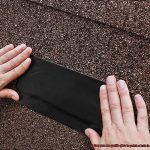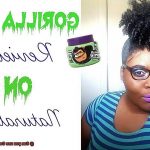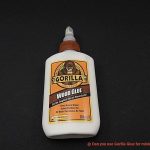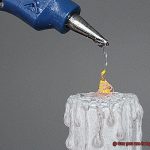Are you tired of dealing with the aftermath of traditional tapes that leave a sticky residue on your walls? Enter Glue Dots – the adhesive solution that promises no mess and easy application. But before you start sticking everything onto your walls, there’s one question that’s bound to cross your mind – do Glue Dots take off wall paint?
If you’re someone who loves decorating or needs to hang things around the house, then the fear of damaging wall paint is a valid concern. So let’s get to the bottom of this question and see if Glue Dots can truly live up to their claims.
In this blog post, we’ll dive into the composition of Glue Dots adhesive and its effect on different types of wall paints. We’ll also cover the proper way to apply and remove Glue Dots, along with precautions you should take. And if you’re still cautious about using them on your walls, we’ve got alternatives for you too.
So, stick around (pun intended) as we unravel the mystery around this much-talked-about adhesive solution and discover if Glue Dots take off wall paint or not.
What are Glue Dots?
Contents
These small, circular dots are a game-changer when it comes to adhesive products.
Glue Dots are made from a pressure-sensitive adhesive applied to a backing material, such as paper or plastic. The dots can be easily peeled off the backing and pressed onto any surface for a strong bond. Unlike liquid glue, there is no risk of spills or drips, and there is no need for brushes or applicators. This makes them easy to use, mess-free, and perfect for crafting, school projects, and packaging needs.
But what sets Glue Dots apart from traditional liquid glue is their versatility. They come in different sizes and strengths to suit various applications. Some are designed for temporary bonding, while others provide a permanent hold. So whether you’re looking to stick posters on a wall or seal packaging boxes, there’s a Glue Dot for every need.
It’s important to note that while Glue Dots are designed to be removable and shouldn’t cause damage when used correctly, there are still potential risks involved. Factors such as the type of paint and wall condition should be considered before using any adhesive products on walls.
Will Glue Dots Damage Paint?
From crafting to packaging and even attaching decorations to walls, these small but mighty dots have a wide range of applications. But before you start sticking them onto your walls, it’s important to ask: will glue dots damage paint?
The answer isn’t as straightforward as a simple yes or no. While glue dots are designed to be removable and generally don’t leave any residue or marks, there are some factors that can increase the risk of paint damage. Let’s take a closer look at what you need to know.
Firstly, the type and quality of paint on your wall can play a significant role in whether glue dots will cause damage. If your wall has a high-quality paint finish, it’s less likely that the glue dots will cause any damage. However, if the paint is of lower quality or has been applied incorrectly, there is a higher risk of damage occurring such as peeling or flaking.
Another factor to consider is how long the glue dots have been on the wall. The longer they are left in place, the more difficult they may be to remove without causing damage to the paint. So it’s important to be gentle when removing the glue dots, especially if they have been in place for a while.
To minimize the risk of paint damage when using glue dots on walls, here are some tips to keep in mind:
- Test the adhesive on a small, inconspicuous area of the wall before using it to attach anything.
- Be gentle when removing the glue dots, especially if they have been in place for a while.
- If you do find that glue dots have caused damage to your wall paint, you can try touching up the damaged area with matching paint or using a solvent-based cleaner to remove any residue left behind by the glue dots.
Factors that Affect Whether or Not Glue Dots Damage Paint
As an expert on the factors that affect whether or not glue dots damage paint, I have some valuable insights to share.
Firstly, it’s crucial to consider the type of paint used on your wall. Glossy or oil-based paints may be more prone to damage as the glue dots may pull off some of the paint when removed. In contrast, flat or matte paints may be less affected by glue dots.
Apart from the type of paint, the duration for which the glue dots are left on the wall can also affect potential damage. If left for an extended period, the adhesive may become difficult to remove and could potentially damage the paint when pulled off.
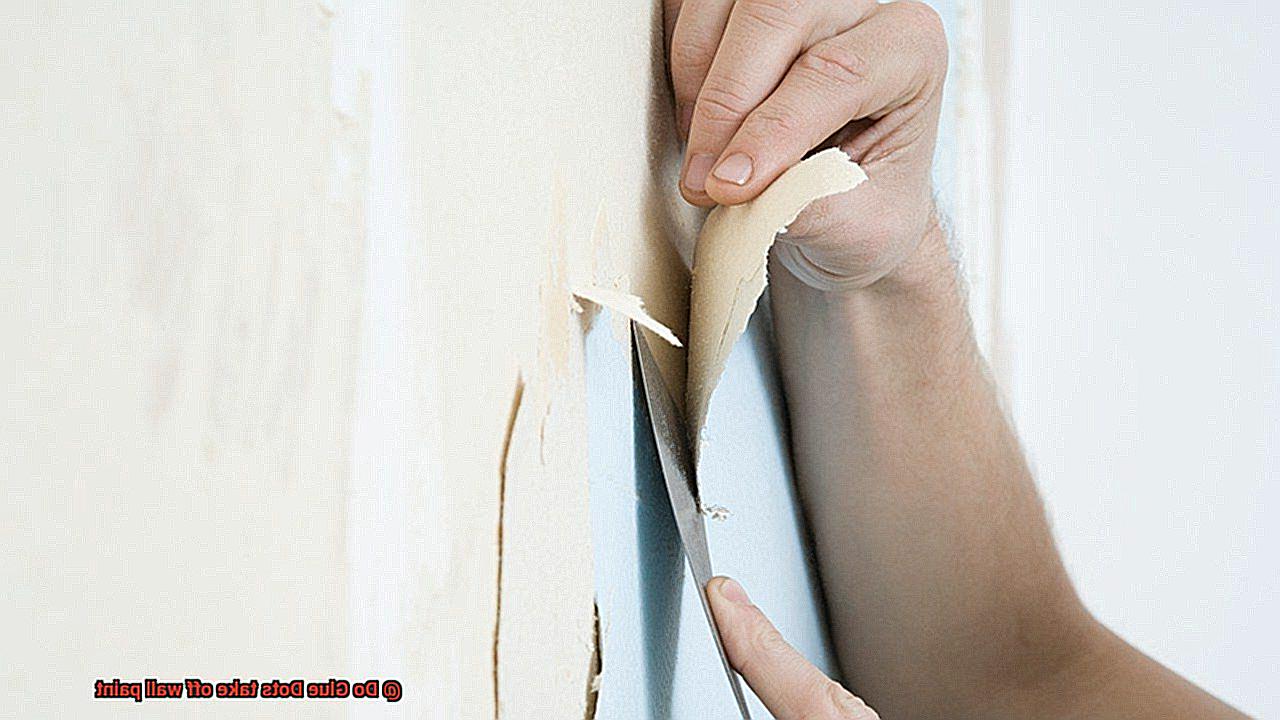
Another factor to consider is the surface texture of your wall. Rougher surfaces may make it challenging for glue dots to adhere properly, resulting in them pulling off some of the paint when removed.
Lastly, the strength of the adhesive used in the glue dots can also impact potential damage. Stronger adhesives may be more likely to pull off some of the paint when removed, while weaker adhesives may not hold objects in place effectively.
To minimize potential damage, it’s advisable to test a small area before applying glue dots more broadly. This will give you an idea of how well they will stick and whether or not they will cause any damage. Also, always remove glue dots carefully and slowly, especially if they have been left on for a while.
Types of Paint and their Resiliency to Adhesive Products
When it comes to decorating your walls, adhesive products like glue dots can be a convenient way to hang up your favorite posters or pictures. However, before you start sticking anything to your walls, it’s essential to know how the type of paint on your walls can affect their resiliency to adhesive products. Here are some key differences between types of paint and their ability to withstand adhesive products:
Flat or Matte Paint
This type of paint has a porous surface that can easily be scratched or damaged by the sticky residue left behind by glue dots. If you have flat or matte paint on your walls, it’s best to avoid using adhesive products altogether or to use them sparingly. Even small amounts of adhesive products can cause damage that is difficult to repair.
Glossy or Semi-Gloss Paint
These types of paints have a smooth surface that makes them more resilient to adhesive products. The stickiness of glue dots does not leave any marks or damage on the paint, but excessive use can still cause damage over time. As long as you use adhesive products in moderation, glossy or semi-gloss paints are a good choice for decorating your walls.
Latex or Acrylic Paint
These types of paint are commonly used on walls and are relatively more resilient to adhesive products than oil-based paints. Latex paints have a smoother surface texture that makes it harder for glue dots to stick and leave any marks or residue. If you’re planning on using adhesive products on your walls frequently, latex or acrylic paints may be the best option for you.
Oil-Based Paint
These paints are more prone to damage from adhesive products like glue dots because they have a rougher surface texture. When removing glue dots from oil-based painted surfaces, small chips or flakes of paint may be removed along with the glue dots. It’s best to avoid using adhesive products on oil-based painted surfaces unless absolutely necessary.
Enamel Paint
Enamel paint is more durable and resistant to scratches and stains than other types of paint. However, it is also more susceptible to damage from adhesive products because of its glossy finish. Removing glue dots from enamel painted surfaces can peel off the topcoat, leading to unsightly damage. If you have enamel painted walls, it’s best to avoid using adhesive products altogether.
The Condition of the Wall Before Using Glue Dots
Before you start sticking them on your wall using adhesive products such as glue dots, it’s crucial to consider the condition of your wall. As an expert on this topic, I’m here to guide you through the necessary steps for using glue dots without causing any damage.
First and foremost, it’s essential to ensure that your wall is in excellent condition. If the paint on your wall is peeling or cracking, avoid using glue dots as they may cause further damage. Using glue dots on clean walls free of debris ensures that the adhesive will stick to the surface. You can accomplish this by wiping the wall with a damp cloth and allowing it to dry completely before applying any adhesive.
The type of paint on your wall also plays a significant role in determining its resilience to adhesive products. Glossy or oil-based paints may be more prone to peeling when removed, while flat or water-based paints may be less likely to be affected.
Therefore, it’s crucial to test a small area first before applying glue dots to the entire wall.
Apply a small dot of adhesive and let it dry before attempting to remove it. If the paint is undamaged, and the adhesive comes off cleanly, then it’s safe to proceed with using glue dots.
Moreover, it’s essential to keep in mind that humidity affects wall conditions. Therefore, avoid applying glue dots during humid weather as they might not stick properly.
How to Prevent Damage from Glue Dots
There are steps you can take to prevent any damage and keep your walls looking pristine. Here are five sub-sections that will guide you on how to prevent any damage caused by glue dots when using them on your walls.
Choose the Right Type of Glue Dot
One of the most important things to consider when using glue dots on your walls is choosing the appropriate type of adhesive for your surface. Opt for a low-tack or removable adhesive strength for walls with delicate paint. This type of glue dot will not cause damage when removed.
Prepare the Surface
Before applying any glue dots, make sure your wall is clean and dry. Dirt or moisture on the surface can weaken the adhesive bond and cause it to pull off paint when removed. Wipe down the surface with a clean cloth and let it dry completely before applying any adhesive.
Test a Small Area
If you’re unsure of how a glue dot will affect your wall, test it on a small, inconspicuous area first. This way, you can see how easily the glue dot comes off and whether any damage occurs. If there is no damage, proceed with applying the rest of the dots.
Remove Carefully
When it’s time to remove the glue dots, do so carefully. Use a plastic scraper or credit card to gently lift the dot from the surface, avoiding using metal tools or fingernails that may scratch or damage the surface. Apply slow and steady pressure to peel off the adhesive instead of pulling it off quickly and forcefully.
Fix any Damage
If you do notice any damage or discoloration after using glue dots, there are solutions available to fix them. You can try using a magic eraser or rubbing alcohol to remove any residue or stains. For more serious damage, touch up the affected area with paint or seek professional help.
0yUQD_QY11Y” >
Conclusion
In summary, Glue Dots offer a hassle-free and efficient adhesive solution for various purposes, including wall decorations. However, the question of whether they strip off wall paint is a valid concern that depends on several factors. The type and quality of paint on your wall, the duration for which the glue dots are left in place, the surface texture of your wall, and the strength of the adhesive used in the glue dots can all impact potential damage.
To minimize any risk, it’s crucial to conduct a small area test before using glue dots extensively and remove them with caution and patience. Furthermore, selecting an appropriate adhesive type for your surface, preparing it beforehand, conducting a small test first, and removing carefully with plastic scraper or credit card instead of metal tools or fingernails that may scratch or damage the surface are some measures you can take to avoid any harm caused by glue dots when using them on your walls.


